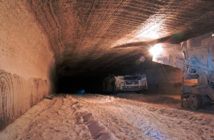
Washington–Morocco Board News- Who carries out investment in Morocco? The evidence shows only central government does; For sure companies do their bit as well, but their investment is not up to scratch. I am referring explicitly to those larger “national champions” who enjoy monopoly (or oligopoly) rents because they are supposedly our only chance to deal with an ever more threatening globalization;
the story goes, let these conglomerates (a private and Moroccan version of Kombinats) concentrate resources, enjoy generous government subsidies and exemptions to grow and go on to get Morocco some business abroad. Their newly acquired resources are then reinvested at home to the benefit of everyone: Maroc Telecom, CDG, ONA-SNI and a few other companies portraying Corporate Morocco have been allowed to practise a large-scale version of trickle-down economics: their powerful economic and political connections prevent any serious threat from regulatory bodies or potential competitor to even ever exist.
But fine, let us roll with that argument for a while: suppose that trickle-down economics is doing fine; that these companies over the past decade have had enough time and resources and profits to build themselves niches and comfortable lead on their respective markets; we should be now expecting some large spending on asset acquisition, we should have a look at these companies’ balance sheets and observe a noticeable increase in their tangible assets, perhaps their inventories, definitely some increase in capital size. But the trouble is, we don’t.
The first thing to record is the significant difference between crony, rent-oriented capitalism, and productive, value-creation capitalism: the latter is based on political patronage, corruption and investment in safe but non-productive sectors, the former is riskier, but tends to generate more activity and more jobs. The last three years recorded an annual average Gross Capital Formation of 270 Bn. That’s 36% of GDP, and as IMF reports:
Although investment rates to GDP have increased significantly over the last decade in Morocco, this has not translated into higher economic growth.
While during 1999-2010 Morocco’s investment rate was the second largest in the sample below, its growth rate is relatively lower. The quality and efficiency of investment projects may contribute to explain these differences.
So Morocco is investing quite a lot -relative to its GDP- but this constant effort does not translate into growth, insofar other emerging countries manage to perform higher growth rate – perhaps Moroccan investments aren’t as profitable to growth as one might think – or, alternatively, these are profitable, but only in terms of monetary, and not real, returns.
 If significant sectors all plummeted over the last three years, how come dividends performed a solid 10% annual increase? |
In addition to that, it is also worth investigating the precise investment share shouldered by private and public operators: it is no use to let the budget bear the brunt of essential investments (whose effects on growth are more of a long-term nature) and let private businesses just get away with it; From a pure financial point of view, companies would not commit resources to buy assets unless there’s some optimistic appraisal of future cash-flows; as far as paid dividends go, there is a healthy 10% annual return cashed in during the last three years, an average of 31Bn over 2008-2011, even though significant sectors -save for banking- took a hit over the same period of time. That’s a 100Bn right into the pockets of a nucleus of shareholders who do not get to invest it in tangible assets.
Levels of dividends are therefore high enough to consider investing assets in whatever company MASI subsumes and able to yield as high a profit as the composite index itself. If a company does manage such high a dividend, surely it can provide enough resources to invest in assets. But instead, they keep on spending them to keep shareholders happy, too happy, perhaps.
But what about public investments? Over the considered last three years, public expenditure (including Hassan II fund and SEGMAs) allocated to investment reached 154 Bn on average (51Bn of it attached to central government) that is 60% of gross capital formation, with the entire private sector providing for the remaining 120Bn average per year. Strangely enough, it seems the entire private sector -those companies large enough to afford equally large spendings in asset acquisition- saw fit not to add some 30Bn every year, or 4 basis points in investments that could well be directed to profitable and productive assets.
 An initial raw indicator: correlation increases over time An initial raw indicator: correlation increases over time |
And it is not like financial products were supposed to yield higher returns: Bank Al Maghrib‘s main rates over the last 3 years were historically low: it was 3.5% in 2008, it is now 3.25%, the lowest level for decades indeed. Investors should, in view of very lenient interest rate constraints, opt in for asset acquisition; as a matter of fact, long-term investments are even better suited at times when liquidity is quite scarce: there is no need to hold cash in order to expand capacity production, network platform or other expenditure needed to increase production of goods and services.
The question might seem trivial, but it would be great to know exactly if investment does help expand growth, if it does indeed; first off, there is a clear correlation between GDP and Gross Capital Formation (the nearest indicator to domestic investment) and not only that, but it tends to increase over time (as the table shows indeed) and computations on annual data shows also a certain ‘pull effect’: while investment surely does not determine growth wholly, it certainly contributes a great deal, perhaps between a third and 40% of it, depending on the number of lags and how one arranges them, and again under certain circumstances, it is safe to say that over the last decade, investment has contributed, on average, 2.2 basis points of GDP growth.
Considering the computations on Morocco’s potential GDP growth, Capital contributes -on average- 43% of potential output, the numbers seem to make sense, and following, could yield good predictions, in the event these annual 30Bn of dividends were spent in asset acquisition rather than going into the pockets of Corporate Morocco’s shareholders: an additional 4 basis points in gross capital formation would have almost no impact on the initial year’s GDP growth, but that nonetheless carry its effect over the next couple of years, and it is safe to believe that future effects on growth are underestimated.
all in all, a constant 4% increase over 3 years, from 2008 to 2011 would have increased average GDP growth from 4.6% to 5.5%, with a potential (residual) residual of 0.3 basis points to gain for the next coming years. Increasing growth to 5.5% would have meant a GDP gain of 120Bn instead of the record 80Bn. Now, ceteris paribus, investing money back would have brought more than the cashed in 100Bn in dividends, a discounted value of 103Bn – an additional 3 Bn that would have generated growth, jobs, income and wealth to these shareholders as well as many others.
The only cost they would have incurred was to wait – no opportunity cost, just the waiting time. But greed it seems, as got the better of sound economic computations, a greed fueled by easy rent-oriented business and a fiscal policy complacent about these activities.






